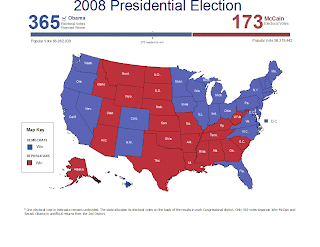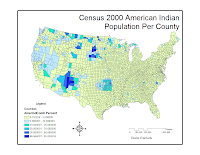Discrete" finite or fixed number of values)grades_'
continuous:" infinite number of values )te,perature_
nominal: categorical data (eye color; six, ethnicity)
ordinal: ordered categorical data, differences between values are not important (restaurant ratings; opinion polls)
interval data: ordered continuous data with a constant scale, but no natural zero (temperature)
differences can be calculated, but rtios are problematic.
ratio data: ordered continuous data with a constant scale and natural zero (geight, weight, age, length).
how they are measured matters in how they are mapped.
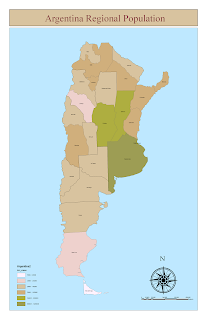 For my first map, I used a typical color distribution to show population density. This looks nice and displays the differences, but only the two extremes really stand out.
For my first map, I used a typical color distribution to show population density. This looks nice and displays the differences, but only the two extremes really stand out.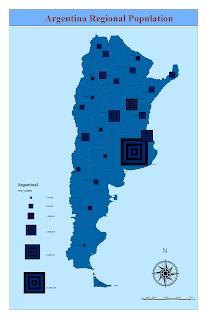 For this map, I chose a different approach for differentiation. I like how the distributions are distributed in such a way as to immediately tell the population size for each region, Buenas Aires having obviously the much greater numbers. The region lines did not show up as well as I thought.
For this map, I chose a different approach for differentiation. I like how the distributions are distributed in such a way as to immediately tell the population size for each region, Buenas Aires having obviously the much greater numbers. The region lines did not show up as well as I thought.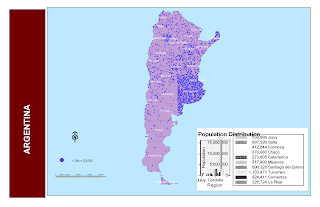 For this map, I wanted to show the population with a little different impact. I also made and inserted a graph. The original showed all the regions and looked very nice. However, when I finished and inserted it, only a few of the regions showed, and I could not change the appearance of the graph itself, such as size and placement of font, etc. I can see why extra items are better off made in another program and inserted.
For this map, I wanted to show the population with a little different impact. I also made and inserted a graph. The original showed all the regions and looked very nice. However, when I finished and inserted it, only a few of the regions showed, and I could not change the appearance of the graph itself, such as size and placement of font, etc. I can see why extra items are better off made in another program and inserted.
